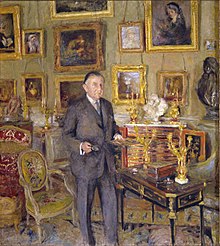David David-Weill

David David-Weill (born August 30, 1871 in San Francisco , † July 7, 1952 in Neuilly-sur-Seine ; born David Weill) was a French banker, art collector and patron.
Life
David Weill was born in San Francisco on August 30, 1871, the son of banker Alexandre Weill and his wife Julie, née Cahn. His parents had left France in 1870 because of the Franco-Prussian War and settled in California, where Raphaël Weill, a brother of their father, lived. David Weill and his parents stayed in the United States for 13 years before returning to France. In Paris, David Weill completed his school education at the Lycée Condorcet and then studied law. After his military service, he began his professional career in the Paris branch of the Lazard Frères banking house , whose founders, the Lazard brothers, were cousins of Alexandre Weill.
family
In 1897 David Weill married Flora Raphaël. From this marriage there were seven children. By decree of April 7, 1929, all members of the family bear the surname David-Weill. His children include Jean David-Weill (1898–1972) , who later became a curator for Islamic art at the Louvre, and the banker and art collector Pierre David-Weill (1900–1975). The daughter Jeanne David-Weill later married the banker Roger Adolphe Léonard Séligmann and the daughter Antoinette David-Weill married Maxime Citroën, a son of the automobile designer André Citroën . His daughter Simone David-Weill married the Baron Henry de Bastard and moved with him to the Hautefort Castle in 1929 . His daughter Marthe Rosetta David-Weill (1904–1980) married the banker Jean Paul Lambiotte (1896–1962); the parents of the actress France Lambiotte .
Patronage
David David-Weill was active as a patron in a variety of ways. He supported educational and medical research institutions as well as hospitals with financial means. His art collection was one of the most important of its kind in France in the first half of the 20th century. In 1928, Édouard Vuillard painted a portrait of the collector, in the background of which Chardin's painting soap bubbles can be seen. As early as the 1930s, he donated Chinese porcelain, Greek and Roman antiquities, European handicrafts and paintings to French museums.
From 1934 until his death he was a member of the Académie des Beaux-Arts . He was also President of the Conseil des musées de France (Advisory Board of French Museums). In 1928 he was one of the co-organizers of an exhibition of ancient American art, and in 1931 he helped organize an exhibition of Byzantine art. As a Jew, David David-Weill hid from Nazi persecution during the Second World War in Montauban . He was able to bring part of his art collection to safety in New York via Lisbon in good time, and he gave another part to the Louvre for security. From these holdings, Reichsleiter Rosenberg's task force confiscated numerous works of art by David Weill, which American troops discovered in various depots towards the end of the war. There were 72 boxes from the David-Weill collection in Buxheim Monastery and more than 1,000 silver works in Neuschwanstein Castle . After the war, most of the stolen items could be returned to David David-Weill.
For his services he was honored as Grand Officier de la Légion d'Honneur . After his death, the former avenue de la porte d'Arcueil in the 14th arrondissement of Paris was renamed avenue David-Weill in his honor in 1960 .
Web links
literature
- Lynn H. Nicholas: The Rape of Europa . Kindler, Munich 1995, ISBN 3-463-40248-3 .
Web links
- Portrait of David David-Weill at alliancefr.com (French)
- Biography David David-Weill on the homepage of the National Gallery of Art (English)
Individual evidence
| personal data | |
|---|---|
| SURNAME | David-Weill, David |
| ALTERNATIVE NAMES | Weill, David |
| BRIEF DESCRIPTION | Banker, art collector and patron |
| DATE OF BIRTH | August 30, 1871 |
| PLACE OF BIRTH | San Francisco , California , United States |
| DATE OF DEATH | July 7, 1952 |
| Place of death | Neuilly-sur-Seine , France |

